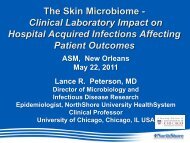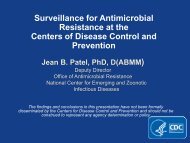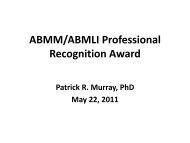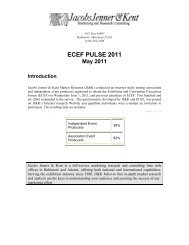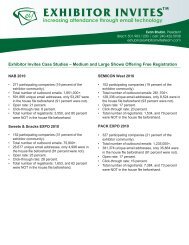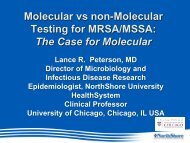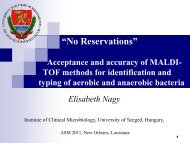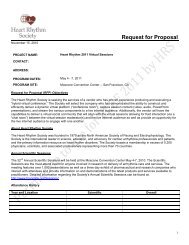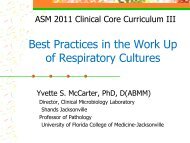USAMRU-K HIV Program Briefing
USAMRU-K HIV Program Briefing
USAMRU-K HIV Program Briefing
You also want an ePaper? Increase the reach of your titles
YUMPU automatically turns print PDFs into web optimized ePapers that Google loves.
Clinical Microbiology Laboratory<br />
Capacity Building in Kenya<br />
CPT Brett E Swierczewski, PhD<br />
Director, Microbiology Hub Kericho<br />
US Army Medical Research Unit – Kenya<br />
(<strong>USAMRU</strong>-K)
Disclaimer: The views expressed in this<br />
presentation are those of the author and not<br />
necessarily of those of the US Army<br />
or the DoD.
Outline<br />
• <strong>USAMRU</strong> – K and Kericho Field Station Overview<br />
• Microbiology Hub Kericho (MHK)<br />
– Overview<br />
– Current studies<br />
– Laboratory capabilities<br />
• Local microbiology capacity building<br />
– Challenges<br />
– Interventions<br />
• Future outlook
<strong>USAMRU</strong>-K Overview<br />
• Established in 1972<br />
• Overseas laboratory<br />
– WRAIR<br />
• Partnership: KEMRI<br />
• Three Sites<br />
– Nairobi: HQ, viral<br />
hemorraghic fever labs<br />
– Kisumu: Malaria and<br />
entomology<br />
– Kericho: <strong>HIV</strong> and enterics
Kericho Field Station Overview<br />
• Clinical Research Center<br />
• Primary mission<br />
– <strong>HIV</strong> operational and<br />
interventional research<br />
– Diagnostics,therapeutics,<br />
and evaluation of vaccine<br />
candidates<br />
– Co-infections: TB<br />
• PEPFAR <strong>Program</strong><br />
• Staff<br />
– 200 Kenyan<br />
– 3 US Personnel<br />
• 2009: Microbiology Hub<br />
Kericho operational
• Personnel<br />
Microbiology Hub Kericho<br />
– 1 Army microbiologist<br />
– 7 Lab technologists<br />
• Sections: CRC, Enterics
Why does the US Army Study Diarrhea?<br />
• Disease non-battle injury<br />
• Operations in Middle East and Africa<br />
– Desert Storm/Shield: 57%<br />
– Somalia: 20%<br />
• AFRICOM<br />
– Deployment of US personnel likely to increase<br />
• Future enterics vaccine development
Current MHK Diagnostic<br />
Capabilities: Enterics<br />
• Enteric bacteria identification and antibiotic<br />
susceptibility<br />
– Conventional methodologies, conventional PCR<br />
– Microscan (automated AST)<br />
• Microscopy for parasites (helminths and protozoans)<br />
– Phase contrast and immunofluorescence<br />
• Rotavirus and norovirus identification<br />
– Real time PCR<br />
• Enrolled in external Quality assurance/Quality control<br />
(QA/QC) proficiency panels
Microbiology Hub Kericho
MHK Current Studies: Enterics<br />
• Surveillance of enteric pathogens of<br />
Kenya<br />
– 5 yr Case-Control study: Acute diarrhea<br />
– District hospitals in western and central Kenya<br />
– Central hospitals and clinics from Kenyan tea<br />
plantations<br />
• 11total surveillance sites<br />
• Demographic information<br />
• Age, water source, rural/urban living area
• Bacteria<br />
Enteric Pathogens Captured<br />
– Shigella spp, Campylobacter spp, Salmonella spp, ETEC,<br />
EAEC, Vibrio cholerae (outbreaks)<br />
– Multidrug resistant<br />
• Parasites<br />
– Giardia lamblia, Entamoeba histolytica/dispar,<br />
Cryptosporidium parvum, Schistosoma mansoni, Ascaris<br />
lumbricoides, Strongyloides stercoralis, hookworm,<br />
Entamoeba spp<br />
• Viruses<br />
– Rotaviruses and noroviruses
Surveillance Site Activation<br />
• Meeting with site staff<br />
– Protocol and ethics training<br />
– Assess laboratory’s capabilities/limitations<br />
• Meeting medical superintendent<br />
• First step: Building local laboratory<br />
capacity<br />
• “What can we do to improve the lab?”
“Dr Brett, can you please help us get<br />
running water in our lab?” (17 May 2011)
Capabilities<br />
Enterics Microbiology Assessment:<br />
Surveillance Sites Laboratories<br />
• Essential media and<br />
stains<br />
– MacConkey, Blood agar<br />
– Gram and trichrome stains<br />
• Equipment<br />
– Autoclave, incubator,<br />
microscope, refrigerator<br />
• Subject matter experts<br />
– Enteric pathogens are<br />
highly endemic<br />
• Biochemical tests<br />
Limitations<br />
• Variable range of<br />
equipment<br />
– e.g. Microscopes<br />
• Lack of some media and<br />
reagents<br />
• Variable staffing levels<br />
• Antibiotic susceptibility<br />
• Biochemical tests<br />
• Sterility, EQA<br />
• Medical maintenance
Microbiology Laboratories (1)
Microbiology Laboratories (2)
Microbiology Laboratories (3)
Microbiology Laboratories (4)
Equipment<br />
• Microscope<br />
• Bunsen burner<br />
• Safety cabinet<br />
• pH meter<br />
• Balance<br />
• Incubator<br />
• Autoclave<br />
“Could you help us get these<br />
reagents and equipment?”<br />
Supplies<br />
• Stool cups<br />
• Media:<br />
– XLD, Sheep blood<br />
• Biochemical tests<br />
– Indole<br />
– Oxidase<br />
– TSI<br />
• Gloves, petri dishes<br />
• Drugs for treatment
• Equipment<br />
MHK Interventions: Laboratory<br />
2 nd Step<br />
– Donated equipment: Microscopes, autoclave, incubator<br />
• Reagents<br />
– About to expire media, API strips, and biochemical<br />
reagents<br />
• Monthly results reports<br />
– Common enteric pathogens at site<br />
– Gear media and reagents to those that are most common<br />
• Outbreaks: Supplies, collection materials, and testing<br />
– Cholera, typhoid fever
New Equipment
• QA/QC<br />
MHK Interventions:<br />
MHK to Laboratory Partnerships<br />
– Positive controls for media preparation<br />
– Temperature monitoring of equipment<br />
– Backup power sources<br />
• External quality control<br />
– Exchange of bacterial isolates between labs<br />
– Permanent stains of protozoans<br />
• Training<br />
– Laboratory staff rotations in the MHK<br />
– Learn new techniques, QA/QC (College of American<br />
Pathologists)
• Infrastructure issues<br />
– Water<br />
Short term outlook<br />
– Renovations of clinic<br />
reception/sample<br />
collection rooms<br />
• Equipment<br />
– Microscopes<br />
– Incubators<br />
– Autoclaves<br />
• QA/QC
Long term outlook<br />
Final Step<br />
• Kericho Field Station: CRC PEPFAR<br />
– 15 laboratory sites: <strong>HIV</strong> diagnosis<br />
– Viral loads, CD4 counts, Hepatitis B and C<br />
– Follow this example for local micro labs<br />
• Continued MHK integration/collaboration<br />
– Kenyan Ministry of Health<br />
– Studies expand: Sites expand<br />
– Civil Affairs units (AFRICOM)<br />
• MEDCAPs
<strong>USAMRU</strong>-K<br />
COL Thomas Logan<br />
Dr Douglas Shaffer<br />
Dr Fred Sawe<br />
MHK Staff<br />
Elizabeth Odundo<br />
AFRIMS<br />
COL Robert Bowden<br />
COL Carl Mason<br />
Acknowledgements<br />
WRAIR<br />
Dr Edwin Oaks<br />
MAJ Max Wu<br />
Kenya<br />
CDC- Kisumu Enterics Lab<br />
Kenyan Staff at Sites
Asante Sana



